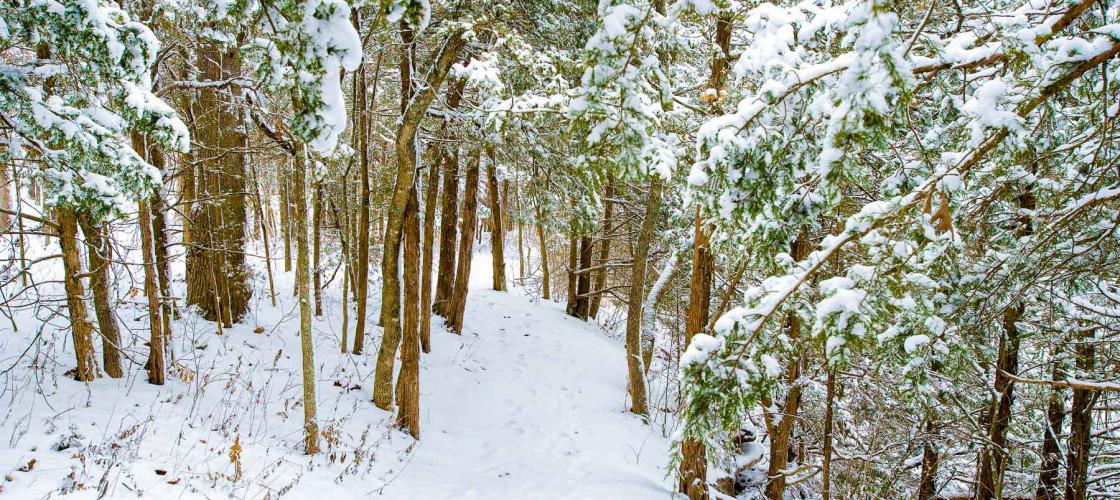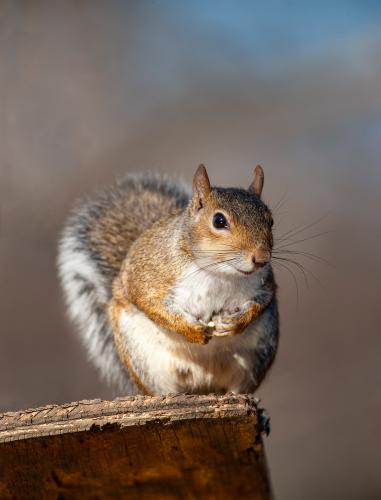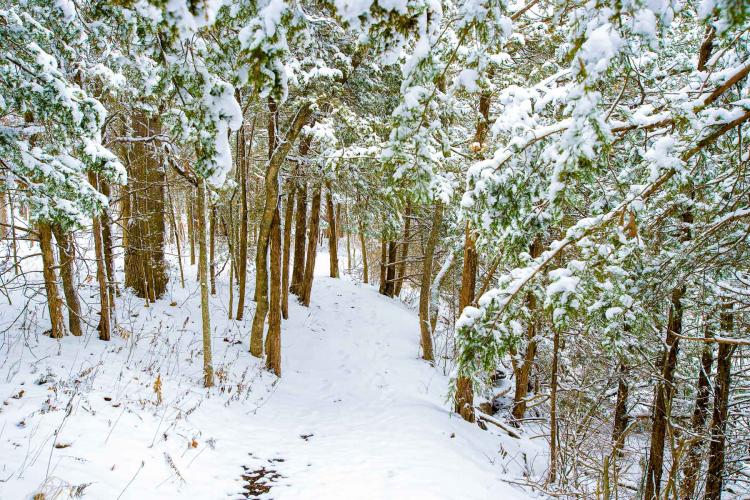
Nature in winter may seem silent and still. But there’s plenty of life to find if you know where to look.
Snow Fleas
If you find tiny black specks in the snow at the base of a tree, it probably isn’t pepper. Tiny creatures called snow fleas become active on sunny winter days. When the flea wants to flee, it releases its spring-loaded tail and flings forward.
Tracks in the Snow
Most mammals prowl around after dark, so you may not see many in the flesh and fur. But footprints in the snow offer evidence of their nightly wanderings.
Foraging Flocks
In winter, birds gather to search the forest for food. If you hear a flock but can’t see it, hiss through your teeth to make a loud pish-pish-pish sound. This noise mimics the alarm call of a wren, and curious birds will fly closer to investigate.
Warning Calls
As you’re walking, pay attention to the sounds of the forest. When animals spot you, many will call out to warn others of danger.
- Black-capped chickadee: Chicka-dee-dee-dee
- Northern cardinal: A metallic chip, chip, chip
- Tufted titmouse: A fussy, scratchy tsee-day-day-day
- Blue jay: A scolding thief, thief, thief
Deer Antlers
White-tailed bucks drop their antlers from late December through February. Search for “sheds” on south-facing hillsides, in crop fields, and along deer trails. If you’re lucky enough to find an antler, you might notice it’s riddled with teeth marks. Rodents gnaw on antlers to get minerals like calcium, which they use to strengthen their bones and teeth.
Eastern Screech-Owl
Look inside tree cavities, and you might find a screech-owl taking a nap. The camouflage pattern on its feathers makes the little bird all but invisible against a barky background. Songbirds sometimes gather near an owl and raise a ruckus to drive the predator away
Hoots
If your hike lasts until twilight, you might hear owls calling to each other.
- Eastern screech-owl: A high-pitched, horselike whinny
- Great horned owl: Hoo, huh-HOO, hooo, hooo.
- Barred owl: A series of hoots that sounds like, “Who cooks for you? Who cooks for you all?”
Owl Pellets
Search the ground underneath a roosting owl’s perch. You might find leftovers from its supper. When an unlucky rodent ends up in an owl’s belly, the soft, meaty parts are quickly digested. Bones, fur, and teeth — which are hard to digest — are barfed up a few hours later as a hairy gray pellet.
White-Breasted Nuthatch
White-breasted nuthatches search trees for insects to eat. The nimble little birds start at the top and creep down the trunk, usually going headfirst.
Stained Snow
Eastern cottontails sometimes stain snow pink, red, orange, or brown with their pee. The off-colored urine is caused by pigments in plants the rabbit has eaten.
Woodpeckers
These head-banging birds are usually easy to locate by their harsh calls and their rat-a-tat-tapping on trees. They hammer to find insects to eat, make nest holes, and tap out messages to fellow woodpeckers.
Butterflies
On warm winter days, keep an eye out for comma and mourning cloak butterflies. These hardy insects hibernate during the depths of winter and wake up when temperatures rise.
Empty Nests
With tree branches bare, look for the empty nests of bald-faced hornets.
Mushrooms
Mushrooms can be found growing on trees (usually dead ones) at any time of the year. As part of nature’s recycling team, they break down dead stuff and turn it into nutrients that other living things use to grow.
Oyster mushrooms are delicious, but never, ever dine on any fungus unless you’re sure it’s safe to eat.
Turkey tail mushrooms are found on nearly every rotting log in the woods. Can you guess why they’re called turkey tails?
If you find an artist conk growing on a tree, use a stick to scratch its snow-white underside. Like magic, wherever you scratch will turn dark.














Also In This Issue

Winning in the wild is about staying alive.
And More...
This Issue's Staff
Alexis (AJ) Joyce
PHOTOGRAPHERS
Noppadol Paothong
David Stonner
DESIGNERS
Marci Porter
Les Fortenberry
ART DIRECTOR
Cliff White
EDITOR
Matt Seek
SUBSCRIPTIONS
Laura Scheuler
MAGAZINE MANAGER
Stephanie Thurber























